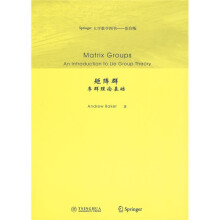Springer大学数学图书·矩阵群:李群理论基础(影印版)

目 录内容简介
Part Ⅰ. Basic Ideas and Examples
1. Real and Complex Matrix Groups
1.1 Groups of Matrices
1.2 Groups of Matrices as Metric Spaces
1.3 Compactness
1.4 Matrix Groups
1.5 Some Important Examples
1.6 Complex Matrices as Real Matrices
1.7 Continuous Homomorphisms of Matrix Groups
1.8 Matrix Groups for Normed Vector Spaces
1.0 Continuous Group Actions
2. Exponentials, Differential Equations and One-parameter Subgroups
2.1 The Matrix Exponential and Logarithm
2.2 Calculating Exponentials and Jordan Form
2.3 Differential Equations in Matrices
2.4 One-parameter Subgroups in Matrix Groups
2.5 One-parameter Subgroups and Differential Equations
3. Tangent Spaces and Lie Algebras
3.1 LieAlgebras.
3.2 Curves, Tangent Spaces and Lie Algebras
3.4 Some Observations on the Exponential Function of a Matrix Group
3.5 SO(3) and SU(2)
3.6 The Complexification of a Real Lie Algebra
4. Algebras, Quaternions and Quaternionic Symplectic Groups
4.1 Algebras
4.2 Real and Complex Normed Algebras
4.3 Linear Algebra over a Division Algebra
4.4 The Quaternions
4.5 Quaternionic Matrix Groups
4.6 Automorphism Groups of Algebras
5. Clifford Algebras and Spinor Groups
5.1 Real Clifford Algebras
5.2 Clifford Groups
5.3 Pinor and Spinor Groups
5.4 The Centres of Spinor Groups
5.5 Finite Subgroups of Spinor Groups
6. Lorentz Groups
6.1 Lorentz Groups
6.2 A Principal Axis Theorem for Lorentz Groups
6.3 SL2(C) and the Lorentz Group Lor(3, 1)
Part Ⅱ. Matrix Groups as Lie Groups
7. Lie Groups
7.1 Smooth Manifolds
7.2 Tangent Spaces and Derivatives
7.3 Lie Groups
7.4 Some Examples of Lie Groups
7.5 Some Useful Formulae in Matrix Groups
7.6 Matrix Groups are Lie Groups
7.7 Not All Lie Groups are Matrix Groups
8. Homogeneous Spaces
8.1 Homogeneous Spaces as Manifolds
8.2 Homogeneous Spaces as Orbits
8.3 Projective Spaces
8.4 Grassmannians
8.5 The Gram-Schmidt Process
8.6 Reduced Echelon Form
8.7 Real Inner Products
8.8 Symplectic Forms
9. Connectivity of Matrix Groups
9.1 Connectivity of Manifolds
9.2 Examples of Path Connected Matrix Groups
9.3 The Path Components of a Lie Group
9.4 Another Connectivity Result
Part Ⅲ. Compact Connected Lie Groups and their Classification
10. Maximal Tori in Compact Connected Lie Groups
10.1 Tori
10.2 Maximal Tori in Compact Lie Groups
10.3 The Normaliser and Weyl Group of a Maximal Torus
10.4 The Centre of a Compact Connected Lie Group
11. Semi-simple Factorisation
11.1 An Invariant Inner Product
11.2 The Centre and its Lie Algebra
11.3 Lie Ideals and the Adjoint Action
11.4 Semi-simple Decompositions
11.5 Structure of the Adjoint Representation
12. Roots Systems, Weyl Groups and Dynkin Diagrams
12.1 Inner Products and Duality
12.2 Roots systems and their Weyl groups
12.3 Some Examples of Root Systems
12.4 The Dynkin Diagram of a Root System
12.5 Irreducible Dynkin Diagrams
12.6 From Root Systems to Lie Algebras
Hints and Solutions to Selected Exercises
Bibliography
Index
1. Real and Complex Matrix Groups
1.1 Groups of Matrices
1.2 Groups of Matrices as Metric Spaces
1.3 Compactness
1.4 Matrix Groups
1.5 Some Important Examples
1.6 Complex Matrices as Real Matrices
1.7 Continuous Homomorphisms of Matrix Groups
1.8 Matrix Groups for Normed Vector Spaces
1.0 Continuous Group Actions
2. Exponentials, Differential Equations and One-parameter Subgroups
2.1 The Matrix Exponential and Logarithm
2.2 Calculating Exponentials and Jordan Form
2.3 Differential Equations in Matrices
2.4 One-parameter Subgroups in Matrix Groups
2.5 One-parameter Subgroups and Differential Equations
3. Tangent Spaces and Lie Algebras
3.1 LieAlgebras.
3.2 Curves, Tangent Spaces and Lie Algebras
3.4 Some Observations on the Exponential Function of a Matrix Group
3.5 SO(3) and SU(2)
3.6 The Complexification of a Real Lie Algebra
4. Algebras, Quaternions and Quaternionic Symplectic Groups
4.1 Algebras
4.2 Real and Complex Normed Algebras
4.3 Linear Algebra over a Division Algebra
4.4 The Quaternions
4.5 Quaternionic Matrix Groups
4.6 Automorphism Groups of Algebras
5. Clifford Algebras and Spinor Groups
5.1 Real Clifford Algebras
5.2 Clifford Groups
5.3 Pinor and Spinor Groups
5.4 The Centres of Spinor Groups
5.5 Finite Subgroups of Spinor Groups
6. Lorentz Groups
6.1 Lorentz Groups
6.2 A Principal Axis Theorem for Lorentz Groups
6.3 SL2(C) and the Lorentz Group Lor(3, 1)
Part Ⅱ. Matrix Groups as Lie Groups
7. Lie Groups
7.1 Smooth Manifolds
7.2 Tangent Spaces and Derivatives
7.3 Lie Groups
7.4 Some Examples of Lie Groups
7.5 Some Useful Formulae in Matrix Groups
7.6 Matrix Groups are Lie Groups
7.7 Not All Lie Groups are Matrix Groups
8. Homogeneous Spaces
8.1 Homogeneous Spaces as Manifolds
8.2 Homogeneous Spaces as Orbits
8.3 Projective Spaces
8.4 Grassmannians
8.5 The Gram-Schmidt Process
8.6 Reduced Echelon Form
8.7 Real Inner Products
8.8 Symplectic Forms
9. Connectivity of Matrix Groups
9.1 Connectivity of Manifolds
9.2 Examples of Path Connected Matrix Groups
9.3 The Path Components of a Lie Group
9.4 Another Connectivity Result
Part Ⅲ. Compact Connected Lie Groups and their Classification
10. Maximal Tori in Compact Connected Lie Groups
10.1 Tori
10.2 Maximal Tori in Compact Lie Groups
10.3 The Normaliser and Weyl Group of a Maximal Torus
10.4 The Centre of a Compact Connected Lie Group
11. Semi-simple Factorisation
11.1 An Invariant Inner Product
11.2 The Centre and its Lie Algebra
11.3 Lie Ideals and the Adjoint Action
11.4 Semi-simple Decompositions
11.5 Structure of the Adjoint Representation
12. Roots Systems, Weyl Groups and Dynkin Diagrams
12.1 Inner Products and Duality
12.2 Roots systems and their Weyl groups
12.3 Some Examples of Root Systems
12.4 The Dynkin Diagram of a Root System
12.5 Irreducible Dynkin Diagrams
12.6 From Root Systems to Lie Algebras
Hints and Solutions to Selected Exercises
Bibliography
Index
目 录内容简介
本书讲述李群和李代数基础理论,内容先进,讲述方法科学,易于掌握和使用。书中有大量例题和习题(附答案或提示),便于阅读。适合用作大学数学系和物理系高年级本科生选修课教材、研究生课程教材或参考书。
比价列表
公众号、微信群
 缺书网
缺书网微信公众号
 扫码进群
扫码进群实时获取购书优惠





